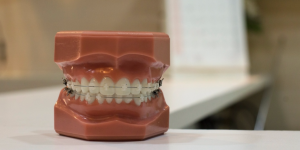A very interesting article courtesy of Dr Jameel Gardee of the Glasgow Smile Clinic – if you are looking for quality dental work such as dental implants Glasgow appears to be one of the top places in the UK for cosmetic dentistry :
In order to complete exceptional cosmetic dentistry that follows the perfection of nature and in addition provides ultimate patient satisfaction, it is necessary to have a holistic approach to smile design and its treatment process.
Dentistry in this field that takes into account only the clinical treatment of the teeth has had some degree of success, but in many cases falls short of achieving the optimum aesthetic effect, primarily due to the fact that other vital components of the smile were not – or were only superficially, considered.
The cosmetic dentists objective is to create a beautiful smile, not just beautiful teeth 1. This can only reach its end point by starting off with a comprehensive evaluation and analysis of the different factors that play a part in the smile, such as facial form, lips and gingivae in addition to the teeth 2 .
Treatment in this holistic manner also allows those undergoing this type of work to be treated with a greater quality of care and provides information to the patient before commencement about those aspects of the smile that may have a deleterious effect to the final cosmetic result if not treated or at least considered. This in turn gives some protection to the dentist 3 as the majority of those seeking cosmetic dentistry may only expect the teeth to be manipulated to provide the result that they are hoping for, being unaware of the importance that the lips and soft tissue play in a beautiful smile. Keeping patients informed about this will lead to more realistic expectations and a greater satisfaction with the cosmetic outcome, with greater predictability comes a greater peace of mind. Unfortunately when this is not done, disappointment may necessitate re-treatment in some cases leading to further costs, time and effort.
Davis in his seminal article on smile design proposed that the successful creation of beautiful smiles requires “artistic skills as well as technical skills” 1 . These artistic skills involve training the eye to see the smiles unseen or overlooked aspects and improving them to make the smile even better. The hard and soft tissues of the teeth and gingivae between the borders of the lips make up the “smile zone” and are in effect the “canvas”of the dental artist. The balance and symmetry between these structures is what cosmetic dentists must evaluate and learn to manipulate to achieve the optimum aesthetic effect 4.
The cosmetic dentist should view things differently from the general dentist. By paying attention to the finer details of the smile which are often hidden to the untrained eye, and improving those aspects, them masterpieces may be created.
Davis further described that artists would look at the canvas and see the hard and soft tissues representing POSITIVE SPACE (light areas ie. the teeth) and NEGATIVE SPACE (dark areas ie. gingivae, space between teeth etc) respectively. Viewing the dental structures in these terms allows the dentist to reshape the positive and negative areas to compliment the shape of the smile zone and as a result bring equilibrium to the smile 5. Ideally the marginal gingivae should be symmetrical right and left, with the lateral incisor zenith about 1mm below the central incisors and canines zenith. The upper limits of the central and canine should be balanced with the internal border of the upper lip as well. The Smile Line which is an imaginary line that follows the incisal edges of the upper anterior teeth should be in harmony with the internal border of the lower lip 5.
The balance of positive and negative space can be shifted using cosmetic re-contouring or cosmetic restorative procedures to adjust the level of the soft tissues, alter tooth form, fill in space and even fill in the buccal corridor 1 .
Achieving this level of cosmetic excellence requires the whole, the parts and the details of the smile to be viewed respectively 6 and to accomplish this the dentist must learn to view his subject from an artists perspective. To aid this process, especially to the untrained eye, digital photography and various imaging softwares may be used. This will allow the dentist to closely examine the relevant components of the smile and train their eyes artistically.
There are many structural aesthetic rules relating to facial form, lips, gingivae and the teeth 5 which are beyond the scope of this article to detail fully. However an appreciation of these in relation to an artists perspective to smile design may be gleaned from the following case studies which have been completed using the principles already described.
CASE 1
A young woman presented, complaining about the unsightly appearance of two old anterior crowns relating to teeth 11 and 12 (Fig 1). She also wished to improve the rest of the smile zone to make it more ideal cosmetically. After a thorough history and full examination (including radiographs, photographs, study models etc), smile evaluation was conducted. When viewing the computer shaded images as part of the evaluation, certain noteworthy findings were recorded and are detailed below :
1.Facial form was charted as being of an Ovoid variety.
2.The smile zone shape was eliptical in nature with an average depth. The upper lip was slightly thin with a slight asymmetry on the patients right side (Fig 2).
3.The positive space did not fill the smile zone and the teeth were generally uneven and misshaped. The right and left sides of the smile zone were asymmetrical particularly due to the worn and rotated canine 13, longer lateral incisor 22 and slightly deeper incisal embrasure between the 14 and 13 (Fig 3). This image also made the excess amount of gingival tissue visible more apparent.
4.Close examination of the gingival tissues in Fig 4 revealed a “gummy smile” with oedematous tissue related to the 11 and 12 probably due to invasion of the biologic width during provision of the unsightly crowns.
After these findings were communicated to the patient, she decided not to proceed with correction of the lip discrepancies but was happy to continue with treatment to address the imbalances in the positive and negative spaces.
A facebow record and bite were taken. From this, a functional diagnostic wax up to golden proportions was completed to include crown lengthening which would help establish proper size, symmetry and proportion of the teeth.
Once the crown lengthening had been done, provisional prototype restorations based on the wax up were placed to further help shape the soft tissue, check occlusal forces and allow a preview of the final result which could be adjusted until the patient was satisfied with the cosmetic appearance. The tissues were then left to heal. Finally two Empress crowns (Ivoclar Vivadent) and four Empress veneers were placed on the six upper anterior teeth and the upper premolars reshaped by stoning. A maxillary occlusal guard was provided and the final “after” photograph shows the completed case with the smile now balanced in the smile zone (Fig 5).
CASE 2
In the second of the two cases a similar complaint presented. However, no violation of the biologic width with the old restorations had occurred and instead there was exposed margins related to the 11 and 21 (Fig 6). The patients facial form was charted as square/tapering. It is worthwhile noting the facial form, as a pleasing shape and tooth form to be used in the final restorations can be identified easily when a Trubyte Tooth Indicator guide (Dentsply) is used at the same time (which can be of use to the Dental Technician in some cases).
Upon examination of the computer shaded images, salient points noted included :
1.Smile zone shape was of a straight/rectangular variety with an average depth. Lip thickness was full and symmetrical (Fig 7). Excess soft tissue from the oral mucosa presented in the smile zone especially above the central incisor region and lip commissure areas. The buccal corridor was charted as narrow.
2.Positive space did not occupy enough of the smile zone (Fig 8). The lateral incisors were short and the 22 in particular was darker than the rest. Exposed root dentine was evident on the 11 and 21. The canine 13 was longer than the 23 affecting the balance of the smile and the gradation effect of the premolars posteriorly was excessive. The lower anterior teeth were crowded and tilted.
3.A large amount of negative space caused by too much displayed gingivae was noted especially over the 22 and 12 (Fig 9).
After consultation with the patient, a treatment plan was designed to include crown lengthening and leveling procedures. Because central incisors tend to be the focal point of the smile, the symmetry of these teeth is key in most smile makeovers so particular attention was paid to the areas above the 12 and 22. Creating dominant central incisors is another element in making a smile appear more youthful 1 which is why symmetry in this area is so important.
Three Empress crowns and three Empress veneers were placed in a treatment process similar to that described in Case 1. The final result shows a more harmonious, fuller looking and balanced smile (Fig 10).
Conclusion
By blending artistic and scientific principles, holistic treatment of the smile zone is made easier. To this end, digital photography and computer imaging are an invaluable tool in training the eye to assess and evaluate the smiles more subtle and hidden elements, not to mention a powerful way of educating those considering cosmetic dental procedures.
By utilizing the principles described in this article, the final end point of the treatment process can hopefully be described a work of art.
REFERENCES
1 Davis N (1999). An artistic approach to smile design. Dentisitry Today 18(8):57-60
2 Mclaren E and Rifkin R (2002). Macroesthetics:facial and dentofacial analysis. Journal California Dental
Association 30(11)839-846
3 Yamalik N (2005). Dentist-patient relationship and quality care. International dental journal 55(2):110-112
4 Levin E (1978). Dental esthetics and golden proportion. Journal of Prosthetic Dentistry 40:244-252
5 Rufenacht C (1990). Fundamentals of Esthetics. Carol Stream III:Quintessence Publishing
6 Tolleth M (1987). Concepts for the plastic surgeon from art and sculpture.Clinical Plastic Surg 14:585-89

